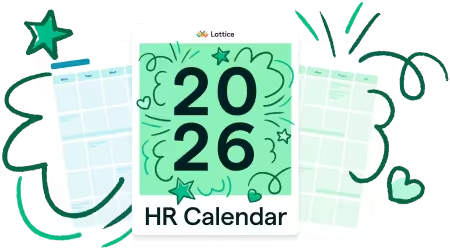Employee Classification Policy Template


Download this template for free
By submitting your information, you agree to Lattice's Terms of Service and Privacy Policy. You can opt out anytime.
Thanks! We'll be in touch soon.
Accurate employee classification isn’t just about internal organization — it’s a legal necessity. Whether determining who’s eligible for overtime or which roles receive benefits, proper classification helps your company comply with labor laws and ensure employees are treated fairly and consistently.
This policy outlines how [Company Name] classifies employees, the different categories used, and what those classifications mean for pay, timekeeping, and benefits eligibility.
What the Employee Classification Policy Should Include
To be effective and compliant, your policy should include:
- Purpose and scope: Why classification matters and who the policy applies to.
- Employment types: Full-time, part-time, temporary, seasonal, and interns.
- FLSA status definitions: Exempt vs. nonexempt (overtime eligibility).
- Independent contractors: Guidelines for classifying non-employees.
- Impact on pay and benefits: What classifications mean in practice.
- Classification review process: How and when roles may be reclassified.
- Legal compliance: Adherence to the Fair Labor Standards Act (FLSA), IRS rules, and relevant state laws.
- Roles and responsibilities: HR and manager accountability.
Purpose of the Employee Classification Policy
The purpose of this policy is to:
- Ensure all roles are classified in alignment with federal, state, and local labor laws.
- Promote consistency and fairness across employment types and departments.
- Help employees understand their rights, responsibilities, and benefits eligibility.
- Minimize legal risk by preventing misclassification.
Sample Employee Classification Policy
{{rich-highlight-1}}
Effective Date: [Insert Date]
Policy Owner: People Team / HR Department
Last Reviewed: [Insert Date]
1. Policy Overview
[Company Name] classifies all employees according to federal and state labor laws, particularly the Fair Labor Standards Act (FLSA). This policy outlines the classification types used across our workforce and helps determine employees’ eligibility for overtime pay, benefits, and timekeeping practices.
Classifications are assigned at the time of hire or role change and are reviewed periodically to ensure accuracy.
2. Employment Types
Full-Time Employees
- Typically work 30 or more hours per week.
- Eligible for the company’s full range of benefits, subject to specific plan terms.
- May be classified as exempt or nonexempt.
Part-Time Employees
- Typically work fewer than 30 hours per week.
- May be eligible for limited benefits, depending on the company’s policies and applicable laws.
- May be exempt or nonexempt.
Temporary or Seasonal Employees
- Hired for short-term assignments, such as special projects, peak season needs, or coverage during employee absences.
- Typically ineligible for benefits unless required by law.
- Generally classified as nonexempt unless duties qualify for exemption.
Interns
- May be paid or unpaid depending on the nature of the internship and legal requirements.
- Not generally eligible for company benefits.
- Internships must comply with Department of Labor guidelines, especially if unpaid.
{{rich-highlight-3}}
3. FLSA Classification
Exempt Employees
- Not entitled to overtime pay under the FLSA.
- Paid on a salary basis.
- Job duties must meet specific exemption tests (e.g., executive, administrative, or professional roles).
- Expected to manage time independently.
Nonexempt Employees
- Eligible for overtime pay (1.5x their regular rate) for hours worked over 40 in a workweek (or as required by state law).
- Must track hours worked daily and report time accurately.
- Typically paid on an hourly basis.
4. Independent Contractors
Independent contractors are not employees of [Company Name]. They:
- Are hired under contract to complete specific projects or services.
- Control how, when, and where they perform their work.
- Are responsible for their own taxes and benefits.
- Are not eligible for employee benefits or covered by employee policies.
[Company Name] uses IRS guidelines and legal counsel to determine contractor status and ensure proper documentation.
5. Classification Impacts
Classification affects key aspects of employment, including:
6. Classification Review and Changes
Employee classifications are reviewed:
- At the time of hire
- When job duties or work schedules change significantly
- During role changes, promotions, or reorganizations
- As required by legal updates
HR and Legal are responsible for reviewing and approving all classification decisions. If a reclassification occurs, the employee will be notified in writing and briefed on any implications for pay, benefits, or timekeeping.
7. Legal Compliance
This policy is guided by:
- The Fair Labor Standards Act (FLSA)
- IRS Independent Contractor Guidelines
- State wage and hour laws
- Applicable Department of Labor and EEOC regulations
[Company Name] is committed to following all relevant employment laws and conducting periodic audits to ensure classification accuracy.
Frequently Asked Questions
1. What’s the difference between exempt and nonexempt?
Exempt employees don’t qualify for overtime pay. Nonexempt employees do — and must track all hours worked.
2. Does my classification affect my benefits?
Yes. Full-time and part-time employees may have different benefit eligibility depending on their classification. Contractors are not eligible for benefits.
3. Can my classification change?
Yes. If your job duties, compensation, or schedule change significantly, HR may reclassify your role. You’ll be notified of any changes in writing.
4. Who decides how my role is classified?
Classifications are determined by HR and reviewed in consultation with legal and your department leadership.
5. What if I think I’ve been misclassified?
Reach out to HR. We take all concerns seriously and will conduct a prompt review.
{{rich-highlight-2}}
🚩 Please note: This sample policy is for informational purposes only and does not constitute legal advice. It is a generic template that may not suit your specific circumstances. When adopting or revising a policy, consult legal counsel to ensure compliance with all applicable laws and regulations.
✨ Disclaimer: This resource was developed with the help of artificial intelligence, though reviewed, edited, and approved by (real) humans.
Frequently Asked Questions

Your people are your business
Ensure both are successful with Lattice.





.webp)